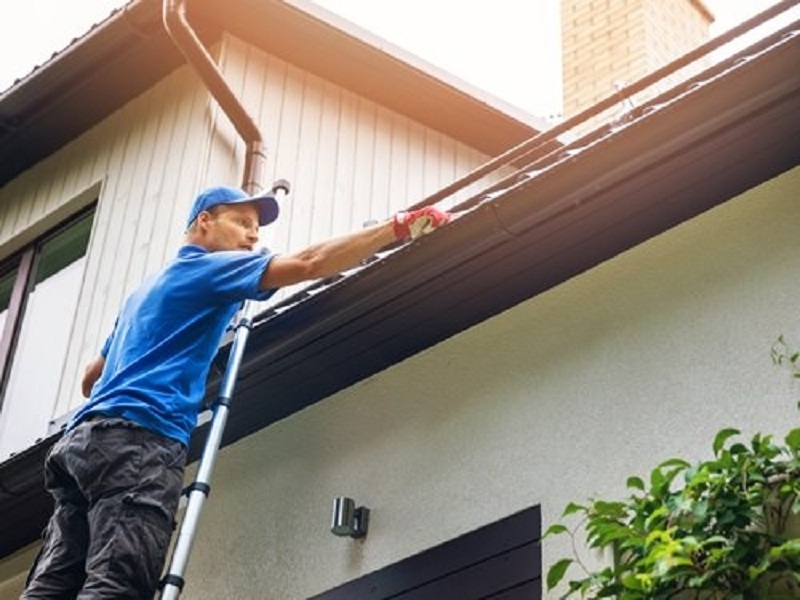The typical design of gutters is to be open, and thus they are more susceptible to accumulating dirt, debris, leaves, branches and more. This can choke the gutters meaning roof gutter cleaning becomes a priority. To deal with this issue, some people install gutter guards.
What are Gutter Guards? What do they do?
Whether it’s a residential or commercial building, maintaining the roof is critical. One of the important aspects of any roof is its gutter system. Guttering is designed to channel the flow of rainwater away from the building.
It also helps in stopping water from accumulating on the roof, which otherwise can lead to damage to the building, like roof leaks and water damage.
Gutter guards are a protective mechanism that helps prevent gutters from clogging. These guards prevent the debris from entering the gutter and only let water pass through.
Different types of gutter guards
There are a number of different gutter guards. Consider what would work with your roof and the surrounding environment.
Mesh– This type of guard has a simple structure. It is made out of metal mesh. It directly covers the gutter, and it is attached to the roof. It is a durable option compared to other gutter guards.
Reverse curve– This is one of the oldest types of gutter guards. It also attaches to the roof but has a curved surface, which helps keep the leaves out of the gutter. While letting the water through, leaves and debris directly fall on the ground.
Bottle brush– This type of guard is made of durable bristles and can be entirely cylindrical or have one flat side. Cylindrical bottle brush guards look like a long bottle cleaner while the flat style look like a toothbrush. The bristles stop leaves and other debris from getting into the gutter.
Nylon– The unique design of this gutter guard comes in handy for preventing snow building up in gutters. It is durable and can easily withstand heavyweights.
Foam– These gutter guards are made of foam. The base is made out of plastic and comes in different shapes to accommodate different gutters. It directly blocks the debris and leaves going into the gutter.
Read here to know How to Clean a Tile Roof?
Now you understand how gutter guards work and the types available, it’s time to consider their pros and cons.
Pros:
- Less maintenance
Installing gutter guards can make a big difference when it comes to gutter cleaning and maintenance. The frequency and duration of gutter cleaning is decreased as the guards reduce how much debris enters the gutters.
- Can be retrofitted
Gutter guards can be added to any roof at any time. You do not have to install them as part of the gutter or roof. You simply add them to the roof as needed. This means it’s also easy to replace any broken gutter guards.
- Reduces incidences of gutters clogging or overflowing
Clogged and overflowing gutters can quickly cause damage to your house. Gutter guards can limit how often these incidents occur.
- May extend the lifespan of gutters
Not only will your gutters require less maintenance, they may also last longer with gutter guards. With clogging and overflowing reduced, there is less chance for water to sit in your gutters and slowly rust the metal. Additionally, gutters are not designed for heavy loads. Reducing the debris that gets stuck in them means they are less likely to bend or pull away from the roof.
- Can help to filter rainwater before it gets to your tank
Many people have rainwater tanks attached to their guttering. While your rainwater tank will have a filter attached, a gutter guard can act as an additional filter. Dirt and debris can be stopped before it enters the tank system, reducing the load on the tank filter.
Cons:
- Can be expensive
Depending on the type of gutter guards you choose and the extent of your guttering, gutter guards can be an expensive addition to your home.
- You can’t completely avoid gutter cleaning
Gutter guards don’t entirely do away with the need for regular roof cleaning. They act as a barrier but they aren’t entirely foolproof. Dirt and debris can still get through. The aim of gutter guards is to reduce how much gets in though.
Even with gutter guards, you should still regularly clean your roof and gutters. You will, however, notice that this job takes less time as there is less debris to deal with.
It’s also important to regularly check your roof for signs of damage and cleaning the gutters is a good reason to get you up there.
- Some cheaper products aren’t as effective
The effectiveness of any gutter guard depends on the quality of the product. A poorly made product will do a poor job.
- Damage to gutters may make guards less effective
If your gutters are damaged, for instance, pulling away from the roof, the gutter guards may not work as well. This is because they are being used in a way that they were not intended to be used.
- Can cause overshooting
Particularly steep roofs can move water very quickly towards gutters. Gutter guards can, unfortunately, make it difficult for fast-moving and high volumes of water to filter into the gutter. Fast-moving water can damage your gutters, or, if it overshoots, the water can pool around your house rather than being directed away from it. This can lead to other issues.
Final thoughts
Whether gutter guards are right for you and your home is a decision up to you. They can be effective in reducing the demands of roof and gutter cleaning maintenance, but they can also have some drawbacks.






